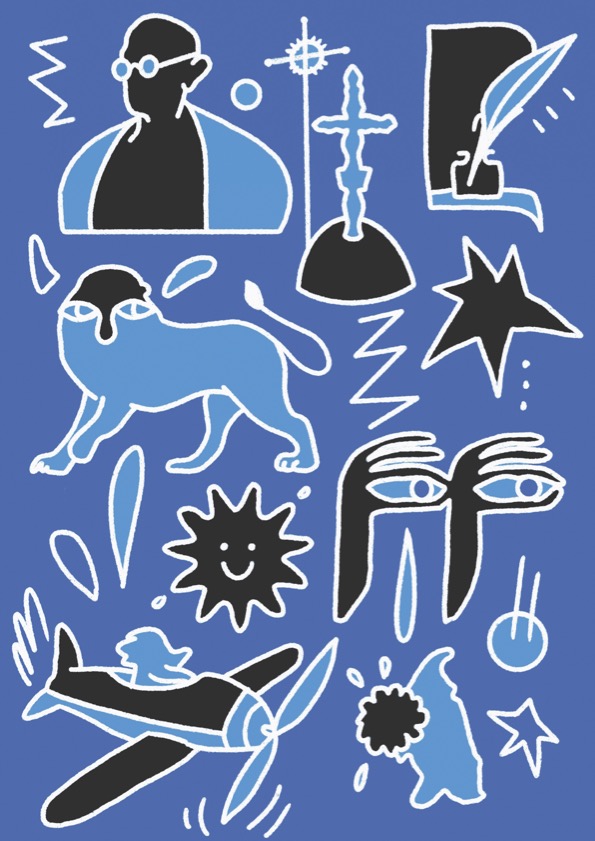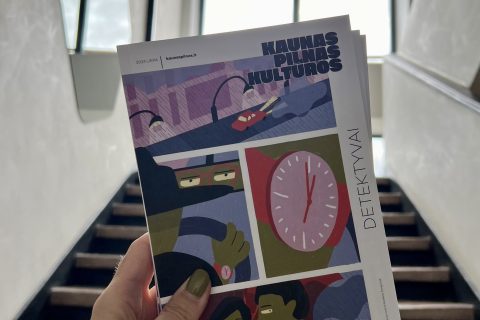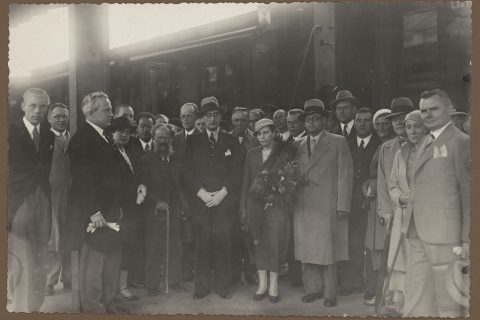“What the hell is Gandhi doing here?” my friend shouts as we cycle through Draugystės Park. “You know, there is a bearded dwarf on one of the bridges of Kaunas!” I shout back to demonstrate my knowledge of the city’s sculptures. “Oh well, just Kaunas things,” she mutters and cycles away.
Indeed. I would have liked to tell her that Gandhi, the leader of Indian national liberation, and that dwarf on the Nemunas Island bridge are actually connected. Both of them are gifts to Kaunas from its sister cities. The statue of Gandhi was erected at the initiative of the Indian Consulate. But why in the park surrounded by apartment blocks? Established in Soviet times, Draugystės (friendship) Park was supposed to symbolize the ties between nations. Now there are plans to put more gifts from sister cities in this park.
Meanwhile, the said dwarf landed here from the Polish city of Wroclaw, where dwarves are believed to bring happiness and joy. The Nemunas Island bridge is quite the symbol of success too. The old Kaunas residents know it unofficially as the “bridge under which Kairys flew his plane” when the pilot’s achievement was recorded in the Guinness Book of World Records.
I’ve been living in Kaunas for four years now, and, to me, being in the city is more about random facts and personal experiences rather than knowing its history. What does it mean to live in Kaunas? I don’t really know; it seems that sometimes it is difficult to describe what it means to be in your own body, to live your own life as if no known words are suitable for describing the experience. The city, it seems, often remains only the background of life, where we run to the trolleybus, meet friends, walk past buildings, and have a favorite store where we don’t have to think much because we know by heart where the cheese and bananas are.

However, when I stop and ask, “And how are you doing Kaunas? What are you hiding under this tile?” The city talks and becomes your fellow traveler. It tells you about the recent episodes of Lithuanian history better than a history book because it has seen it all. I often think about the fact that nowhere else have I felt and understood the Lithuanian tragedy, the extent of the deportations so deeply. Here in Kaunas, it is visible in the memorial plaques, the divided residential interwar period houses, the walls of the former owners’ houses covered with cheap Soviet paint, the square that hosted the first Song Festivals and from which people were deported a dozen years later.
It is reflected in seemingly small or indistinct episodes. Now a commemorative plaque for the Minister of Foreign Affairs of the Republic of Lithuania, political prisoner and exile Juozas Urbšys can be found on one of the houses in Kovo 11-osios Street. Do you know what he saw through the windows while living in this house? A Soviet army heavy artillery gun, standing right next to the Sixth Fort of the Kaunas fortress. The environment can be used to scare a person, but beautiful things can also be created in the same environment. Back in the 1990s, a hill of crosses chaotically formed on the site of the gun. I hope Urbšys managed to see these signs of Independence.
In addition to beautiful and sad historical stories, to me, life in Kaunas is about a slow walk along Laisvės Avenue, long lines at cafes, several heart attacks when the dogs of Žaliakalnis courtyards suddenly bark at you, wooden houses with flowerbeds and the lions. I am sure that Kaunas residents did not raise their eyebrows at the ‘lions’ because to some, lions mean Vytautas the Great War Museum, and the photograph found in every Kaunas resident’s photo album of a kid on the lion’s back. To others, such exotica of the city and lions roaring before bed is common because the zoo is located nearby. By the way, it also borders one of my favorite valleys, named after Adomas Mickevičius. It was named after the poet for a reason – Mickevičius was getting inspired here and also a farewell party was held for him in the valley, during which a stone was dedicated to the poet. I understand why he praised and frequented this peaceful part of nature: the valley flirts with your eyes every season. I do wonder, how many new poems didn’t see the light of day because, it seems, that Mickevičius, who did not have GPS or Google Maps, didn’t have a hard time finding the valley like the current Kaunas poets do. After sharing the photos of the place, I often have to vaguely explain how to get there. Just don’t go through the zoo’s wolf cages!
But I’ve stayed too long in the local neighborhood; there are exotic things in other parts of Kaunas too. For example, you only need to head to Panemunė Pinewood, less commonly referred to by its official name, Jonas Basanavičius Park. It is well-known to Kaunas residents, and the crowds flock there when the ‘Lithuanian syndrome’ intensifies: the need to go for a walk as soon as the first spring or last warm autumn sun shines. I am no exception – in such instances, I happily join the crowd and make my way to my favorite path: the section of Žuvėdrų and Lakštingalų alleys. No matter which side you start from, whether from the upper Panemunė or from the Panemunė path, it is always best to travel when the evening sun shines in April or May, as the sun’s rays beautifully fall between the pine needles. If you don’t look for insects under your feet, you will see a sign on one of the trunks that says, “Energy vortex. 300 meters.” According to the discoverer (founder? feeler?) of this place, “In this vortex, you can feel a warm, calming energy that revives and strengthens the bond between parents and children. In this place, you can also draw from the energy of creativity, self-confidence, and other strong vibrations.” And you still didn’t believe me when I said I look for exotic things in the pinewood.
This is not the only atmospheric place in Kaunas. If you get the blues, there’s always Liūdesio (sorrow) Avenue in Aleksotas waiting for you. After that, you can take a walk on Vilties (hope) Street and then think about the future in Svajonių (dream) Avenue. Every story has a beautiful ending, and this can only be confirmed by Grožio (beauty) Avenue located at the intersection of all these streets. I had to visit this place in Aleksotas right next to the Botanical Garden, after all, when your surname is SADauskaitė, you have to take a selfie next to the sign that says Liūdesio Avenue. There are also beautiful street names in Naujamiestis. For example, Kriaušių (pear), Vyšnių (cherry), Obuolių (apple), and Braškių (strawberry) streets, located on the edge of the Owl Hill, are connected into a quarter by the locals who affectionally call it ‘a compote’. I can already hear my man grumbling in the background, trying to prove to me that no one calls these streets that. Still, I don’t give up and continue to romanticize and imagine streets full of the most delicious aromas romantically.

Which points of the city do you usually rush to? Skalsa, Soboras, or the fountain? I remember the first time I heard that a person would be waiting for me near Skalsa. I couldn’t understand why I was unable to find such a street in the taxi app. It takes time for Kaunas-specific terms to become a natural part of one’s vocabulary, and the advanced level of Kaunasian kicks in when you start navigating around the city using Kaunas-specific terms. On this occasion, let’s imagine a journey along the paths of a fictional character. He travels around the city, visiting places that may not have existed at the same time, but left an imprint on the everyday language of Kaunas residents of different generations.
I decided to get off at Mažasis Paryžius and walk the Laisvės Avenue. I met a friend I hadn’t seen in a long time near the fountain. “I wasn’t late only because of the clever taxi driver who found me immediately in the Bermuda Triangle,” my friend said, taking me toward Tulpė. I, of course, would rather eat a sausage from Skalsa than sit at a white tablecloth and a cup of black coffee. However, the mood improved when I met a few friends from menkė inside. We quickly decided that today we would solve cosmic riddles. There is a new night program at Orbita and Venera and a new movie screening in Planeta. Or maybe I should stay grounded and go to Aura, Daina, or Pasimatymas? Or perhaps I should exchange all this for a meeting with the librarian Asta from Kaunistika. I ran to her house in Slabodkė, but she was already waiting for me in Boškė. After talking about the routines, we had a wish to be closer to the sky and got up to the roof of the Resurrection Church, where we put our heads together and reviewed the panorama: Santaka, Vitebskas, and even a bit of Brazilka terraces. We ended the evening under the feet of Laisvė, observing the gracefully frozen bronze flag. In this city, I can choose to stand under Laisvė’s feet or walk on it, but I am never without it.
Even though I am a non-fictional character, I also know how to travel through time. One of the first memories of Kaunas pops up in my head. I am six and we are going up Parodos Hill in my parent’s car. It’s the golden hour, I am eating ice cream and looking out the window at the trees moving quickly past us; The Velvet Underground’s “Take a Walk on a Wild Side” is playing on the radio. Everything seemed perfect and this episode became one of the key memories of a city in which I neither lived nor planned to live at the time. But now I can confidently say that I moved to Kaunas thanks to Lou Reed. He encouraged me to try another way: I decided to settle here in five minutes (that’s how long it takes – 1056 steps, that is – to climb the Parodos Hill!) but it happened 20 years after the aforementioned memory. Kaunas presented me with quite a few puzzles but now I think that the city presents every newcomer with a “Kaunas is X” gift and invites you to examine it from different angles. I’m still searching and asking Kaunas endless questions, “So what’s under that tile? What’s in this pinewood and on this street?” Maybe in the long run I will be able to figure out what’s behind the mysterious unknown. Just don’t be surprised if your X doesn’t match up with the other explorers’ X. City exploration isn’t math, it’s a game with different levels of intricacy.




